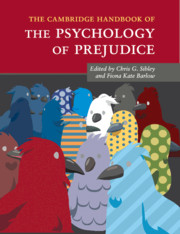Book contents
- Frontmatter
- Dedication
- Contents
- List of Figures
- List of Tables
- Notes on the Contributors
- Part I General Theoretical Perspectives
- Part II Prejudice in Specific Domains
- 11 Understanding the Nature, Measurement, and Utility of Implicit Intergroup Biases
- 12 Aversive Racism and Contemporary Bias
- 13 Ambivalent Sexism in the Twenty-First Century
- 14 Sexism in Intimate Contexts: How Romantic Relationships Help Explain the Origins, Functions, and Consequences of Sexist Attitudes
- 15 Religion and Prejudice
- 16 Sexual Prejudice: Advances in Conceptual and Empirical Models
- 17 Weight Bias: Prejudice and Discrimination toward Overweight and Obese People
- 18 Prejudice Against Immigrants in Multicultural Societies
- 19 Generalized Prejudice: Old Wisdom and New Perspectives
- Part III Prejudice Reduction and Analysis in Applied Contexts
- Index
- References
17 - Weight Bias: Prejudice and Discrimination toward Overweight and Obese People
from Part II - Prejudice in Specific Domains
Published online by Cambridge University Press: 17 November 2016
- Frontmatter
- Dedication
- Contents
- List of Figures
- List of Tables
- Notes on the Contributors
- Part I General Theoretical Perspectives
- Part II Prejudice in Specific Domains
- 11 Understanding the Nature, Measurement, and Utility of Implicit Intergroup Biases
- 12 Aversive Racism and Contemporary Bias
- 13 Ambivalent Sexism in the Twenty-First Century
- 14 Sexism in Intimate Contexts: How Romantic Relationships Help Explain the Origins, Functions, and Consequences of Sexist Attitudes
- 15 Religion and Prejudice
- 16 Sexual Prejudice: Advances in Conceptual and Empirical Models
- 17 Weight Bias: Prejudice and Discrimination toward Overweight and Obese People
- 18 Prejudice Against Immigrants in Multicultural Societies
- 19 Generalized Prejudice: Old Wisdom and New Perspectives
- Part III Prejudice Reduction and Analysis in Applied Contexts
- Index
- References
Summary
Why did they call me names? I was a nice little girl. Is there a name for this?
Why am I supposed to hate myself until I reach my “ideal” weight? Is there a name for this?
Why do I rarely see anyone who looks like me in women's magazines, on TV, or in the movies? Is there a name for this?
Why can't large people go to the theatre or ride on a plane in comfort? Is there a name for this?
Why was a job withheld from me because “we can't have you out in front”? Is there a name for this?
Yes, there is a name for this – the name is discrimination.
(Johnson, 2001, p. 101)Definition and Prevalence of Weight Bias
Weight bias refers to stigmatization, bullying, prejudice, and discrimination against overweight and obese individuals based on their body weight and appearance (Puhl & Brownell, 2003). It can manifest in prejudiced implicit and explicit attitudes, including the attribution of negative stereotypes (e.g., unattractive, lazy, unclean, gluttonous, unintelligent, unhealthy) toward overweight and obese people. It also includes discriminatory actions toward an individual based on their weight and appearance, such as suboptimal health care and employment inequities. As this chapter shows, extensive evidence demonstrates that overweight and obese individuals are at significantly greater risk for institutional and interpersonal prejudice and discrimination because of their higher weight (Carr & Friedman, 2005). Although a substantial amount of research, policy, advocacy, and social action has been dedicated to understanding the causes of, and methods for preventing, other forms of discrimination (e.g., race and sexuality), policy and social action addressing weight bias has thus far been limited (Brownell, 2005). It has been suggested that weight bias is the last socially acceptable form of discrimination (Puhl & Brownell, 2001). This neglect is concerning given research demonstrating that experiencing weight bias can impair psychological and physical health, hinder economic and employment opportunities, and impede academic performance and education.
In the United States, weight discrimination is one of the most common forms of discrimination reported by women and men (Puhl, Andreyeva, & Brownell, 2008). Unlike other forms of discrimination that have remained stable in recent decades, reports of weight discrimination were found to increase by 66%, from 7% in 1995–1996 to 12% in 2004–2006 (Andreyeva, Puhl, & Brownell, 2008).
- Type
- Chapter
- Information
- The Cambridge Handbook of the Psychology of Prejudice , pp. 392 - 412Publisher: Cambridge University PressPrint publication year: 2016
References
- 10
- Cited by



